Fuel rail VOLVO XC90 2007 Owners Manual
[x] Cancel search | Manufacturer: VOLVO, Model Year: 2007, Model line: XC90, Model: VOLVO XC90 2007Pages: 268, PDF Size: 8.57 MB
Page 54 of 268
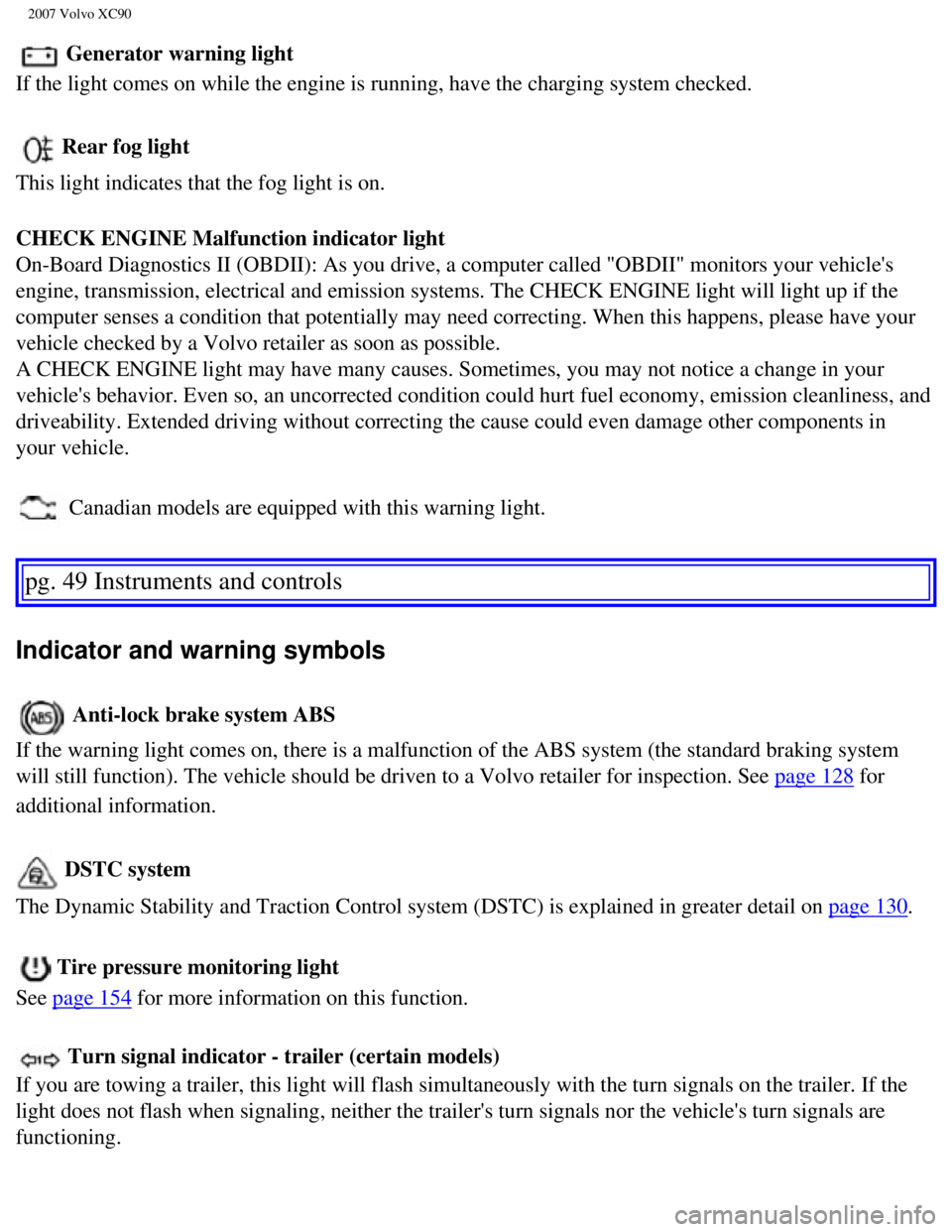
2007 Volvo XC90
Generator warning light
If the light comes on while the engine is running, have the charging sys\
tem checked.
Rear fog light
This light indicates that the fog light is on.
CHECK ENGINE Malfunction indicator light
On-Board Diagnostics II (OBDII): As you drive, a computer called "OBDI\
I" monitors your vehicle's
engine, transmission, electrical and emission systems. The CHECK ENGINE \
light will light up if the
computer senses a condition that potentially may need correcting. When t\
his happens, please have your
vehicle checked by a Volvo retailer as soon as possible.
A CHECK ENGINE light may have many causes. Sometimes, you may not notice\
a change in your
vehicle's behavior. Even so, an uncorrected condition could hurt fuel ec\
onomy, emission cleanliness, and
driveability. Extended driving without correcting the cause could even d\
amage other components in
your vehicle.
Canadian models are equipped with this warning light.
pg. 49 Instruments and controls
Indicator and warning symbols
Anti-lock brake system ABS
If the warning light comes on, there is a malfunction of the ABS system \
(the standard braking system
will still function). The vehicle should be driven to a Volvo retailer \
for inspection. See
page 128 for
additional information.
DSTC system
The Dynamic Stability and Traction Control system (DSTC) is explained \
in greater detail on
page 130.
Tire pressure monitoring light
See
page 154 for more information on this function.
Turn signal indicator - trailer (certain models)
If you are towing a trailer, this light will flash simultaneously with t\
he turn signals on the trailer. If the
light does not flash when signaling, neither the trailer's turn signals \
nor the vehicle's turn signals are
functioning.
file:///K|/ownersdocs/2007/2007_XC90/07xc90_02.htm (8 of 40)12/30/2006\
5:53:37 PM
Page 125 of 268
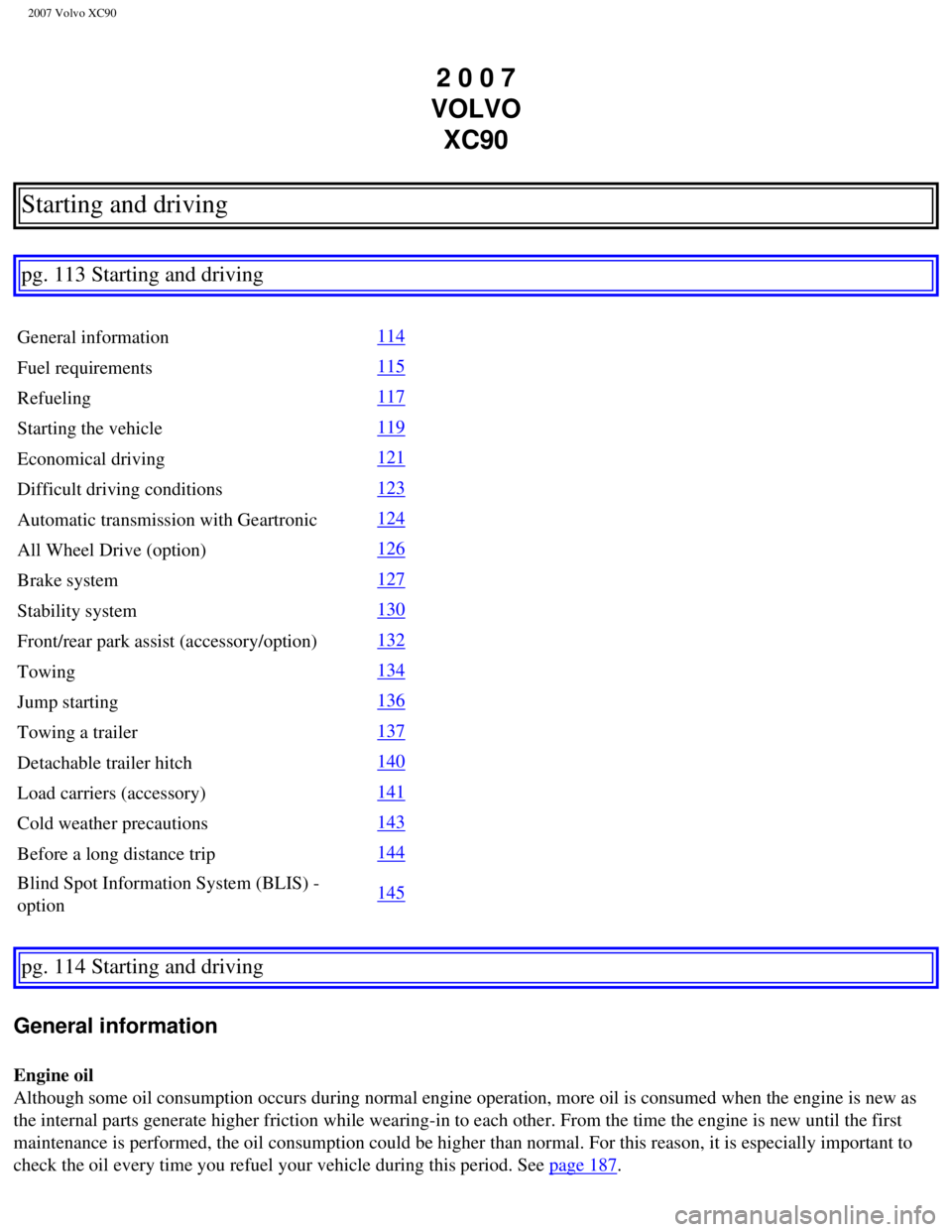
2007 Volvo XC90
2 0 0 7
VOLVO XC90
Starting and driving
pg. 113 Starting and driving
General information
114
Fuel requirements
115
Refueling
117
Starting the vehicle
119
Economical driving
121
Difficult driving conditions
123
Automatic transmission with Geartronic
124
All Wheel Drive (option)
126
Brake system
127
Stability system
130
Front/rear park assist (accessory/option)
132
Towing
134
Jump starting
136
Towing a trailer
137
Detachable trailer hitch
140
Load carriers (accessory)
141
Cold weather precautions
143
Before a long distance trip
144
Blind Spot Information System (BLIS) -
option
145
pg. 114 Starting and driving
General information
Engine oil
Although some oil consumption occurs during normal engine operation, mor\
e oil is consumed when the engine is new as
the internal parts generate higher friction while wearing-in to each oth\
er. From the time the engine is new until the first
maintenance is performed, the oil consumption could be higher than norma\
l. For this reason, it is especially important to
check the oil every time you refuel your vehicle during this period. See\
page 187.
file:///K|/ownersdocs/2007/2007_XC90/07xc90_06.htm (1 of 32)12/30/2006\
5:53:44 PM
Page 127 of 268
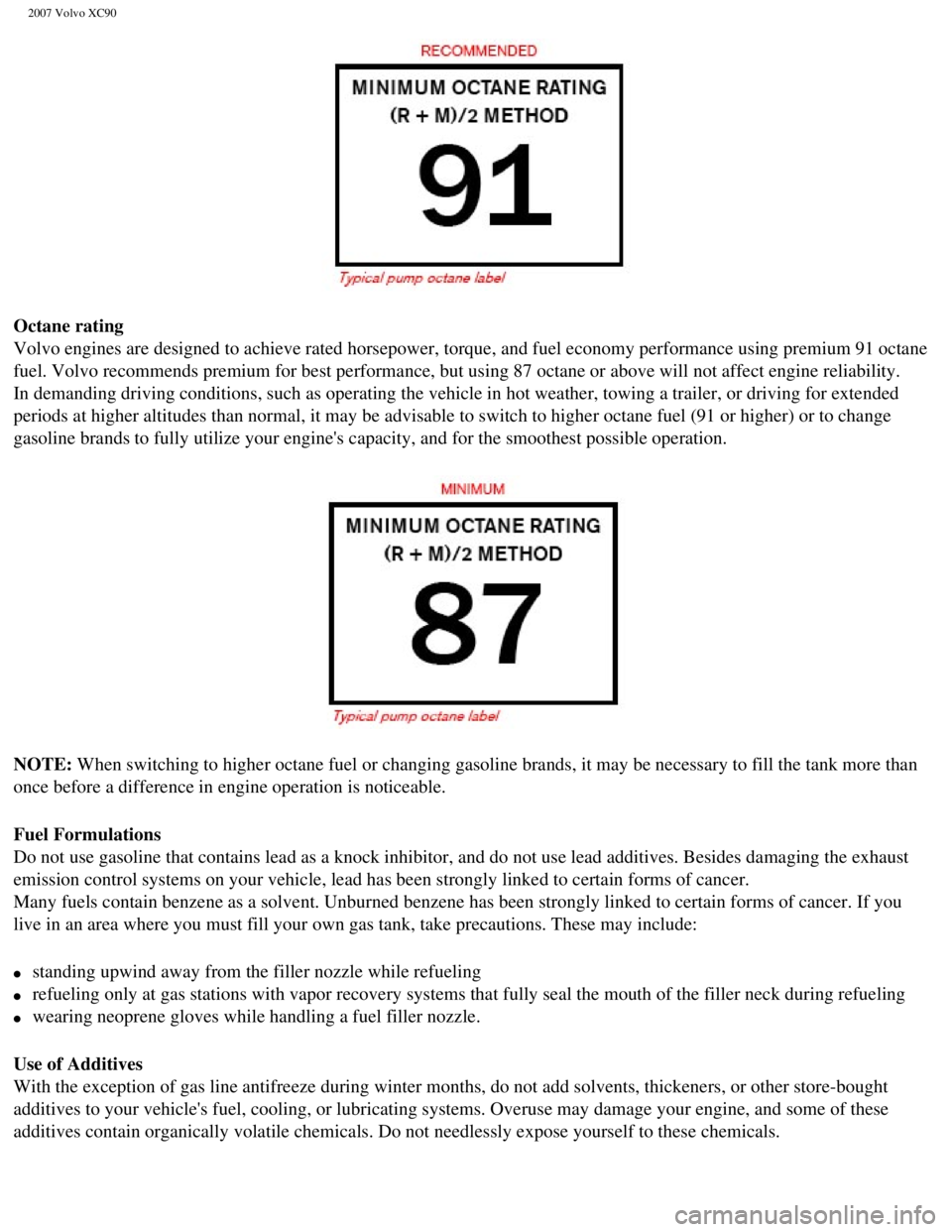
2007 Volvo XC90
Octane rating
Volvo engines are designed to achieve rated horsepower, torque, and fuel\
economy performance using premium 91 octane
fuel. Volvo recommends premium for best performance, but using 87 octane\
or above will not affect engine reliability.
In demanding driving conditions, such as operating the vehicle in hot we\
ather, towing a trailer, or driving for extended
periods at higher altitudes than normal, it may be advisable to switch t\
o higher octane fuel (91 or higher) or to change
gasoline brands to fully utilize your engine's capacity, and for the smo\
othest possible operation.
NOTE: When switching to higher octane fuel or changing gasoline brands, it ma\
y be necessary to fill the tank more than
once before a difference in engine operation is noticeable.
Fuel Formulations
Do not use gasoline that contains lead as a knock inhibitor, and do not \
use lead additives. Besides damaging the exhaust
emission control systems on your vehicle, lead has been strongly linked \
to certain forms of cancer.
Many fuels contain benzene as a solvent. Unburned benzene has been stron\
gly linked to certain forms of cancer. If you
live in an area where you must fill your own gas tank, take precautions.\
These may include:
l standing upwind away from the filler nozzle while refueling
l refueling only at gas stations with vapor recovery systems that fully se\
al the mouth of the filler neck during refueling
l wearing neoprene gloves while handling a fuel filler nozzle.
Use of Additives
With the exception of gas line antifreeze during winter months, do not a\
dd solvents, thickeners, or other store-bought
additives to your vehicle's fuel, cooling, or lubricating systems. Overu\
se may damage your engine, and some of these
additives contain organically volatile chemicals. Do not needlessly expo\
se yourself to these chemicals.
file:///K|/ownersdocs/2007/2007_XC90/07xc90_06.htm (3 of 32)12/30/2006\
5:53:44 PM
Page 134 of 268
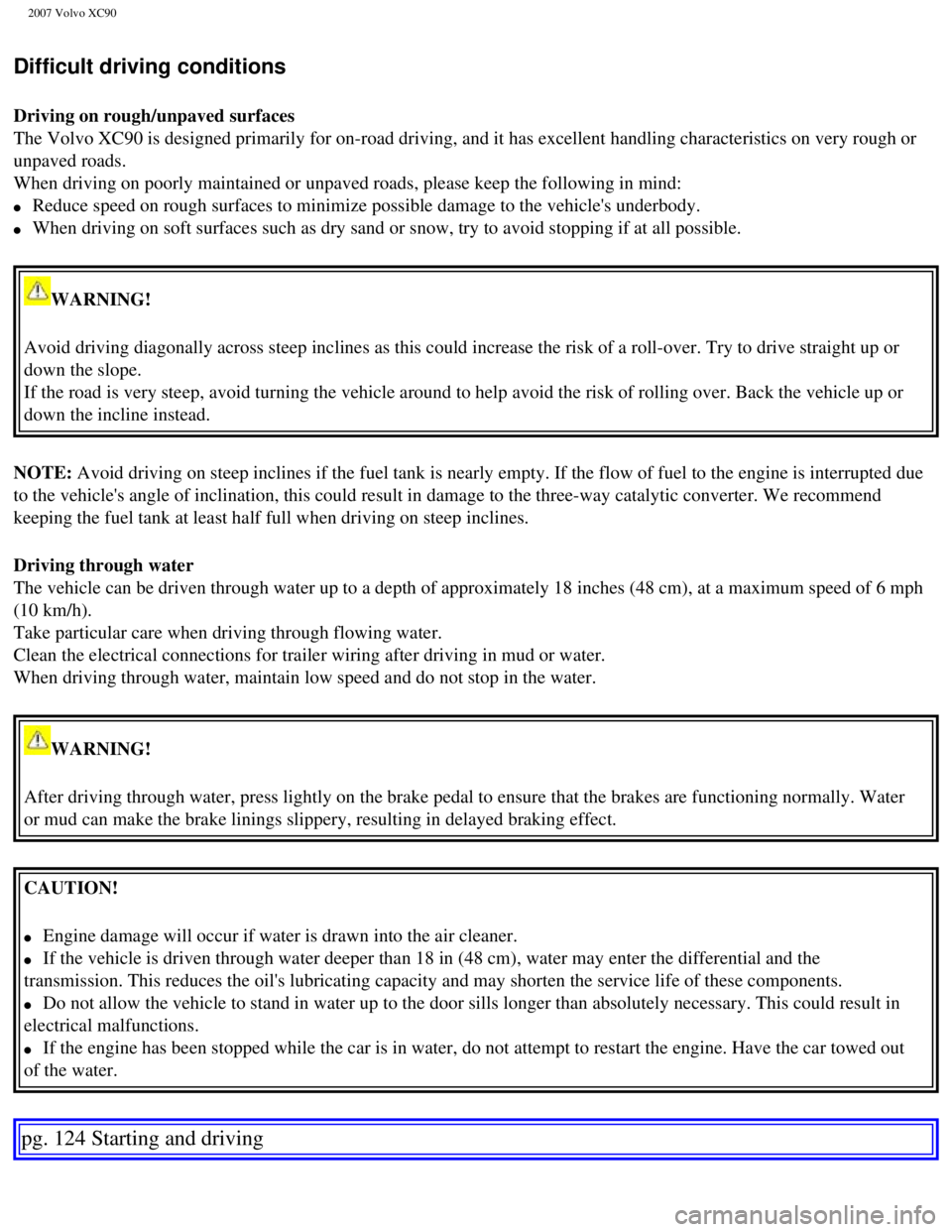
2007 Volvo XC90
Difficult driving conditions
Driving on rough/unpaved surfaces
The Volvo XC90 is designed primarily for on-road driving, and it has exc\
ellent handling characteristics on very rough or
unpaved roads.
When driving on poorly maintained or unpaved roads, please keep the foll\
owing in mind:
l Reduce speed on rough surfaces to minimize possible damage to the vehicl\
e's underbody.
l When driving on soft surfaces such as dry sand or snow, try to avoid sto\
pping if at all possible.
WARNING!
Avoid driving diagonally across steep inclines as this could increase th\
e risk of a roll-over. Try to drive straight up or
down the slope.
If the road is very steep, avoid turning the vehicle around to help avoi\
d the risk of rolling over. Back the vehicle up or
down the incline instead.
NOTE: Avoid driving on steep inclines if the fuel tank is nearly empty. If th\
e flow of fuel to the engine is interrupted due
to the vehicle's angle of inclination, this could result in damage to th\
e three-way catalytic converter. We recommend
keeping the fuel tank at least half full when driving on steep inclines.\
Driving through water
The vehicle can be driven through water up to a depth of approximately 1\
8 inches (48 cm), at a maximum speed of 6 mph
(10 km/h).
Take particular care when driving through flowing water.
Clean the electrical connections for trailer wiring after driving in mud\
or water.
When driving through water, maintain low speed and do not stop in the wa\
ter.
WARNING!
After driving through water, press lightly on the brake pedal to ensure \
that the brakes are functioning normally. Water
or mud can make the brake linings slippery, resulting in delayed braking\
effect.
CAUTION!
l Engine damage will occur if water is drawn into the air cleaner.
l If the vehicle is driven through water deeper than 18 in (48 cm), wate\
r may enter the differential and the
transmission. This reduces the oil's lubricating capacity and may shorte\
n the service life of these components.
l Do not allow the vehicle to stand in water up to the door sills longer t\
han absolutely necessary. This could result in
electrical malfunctions.
l If the engine has been stopped while the car is in water, do not attempt\
to restart the engine. Have the car towed out
of the water.
pg. 124 Starting and driving
file:///K|/ownersdocs/2007/2007_XC90/07xc90_06.htm (10 of 32)12/30/200\
6 5:53:44 PM
Page 169 of 268

2007 Volvo XC90
Properly loading your vehicle will provide maximum return of vehicle des\
ign performance.
Before loading your vehicle, familiarize yourself with the following ter\
ms for determining your vehicle's
weight ratings, with or without a trailer, from the vehicle's Federal/ C\
anadian Motor Vehicle Safety
Standards (FMVSS/CMVSS) label, and the vehicle's tire information plac\
ard.
Curb weight
The weight of the vehicle including a full tank of fuel and all standard\
equipment. It does not include
passengers, cargo, or optional equipment.
Capacity weight
All weight added to the curb weight, including cargo and optional equipm\
ent. When towing, trailer hitch
tongue load is also part of cargo weight.
NOTE: For trailer towing information, please refer to the section "Towing a t\
railer" on
page 137.
Permissible axle weight
The maximum allowable weight that can be carried by a single axle (fron\
t or rear). These numbers are
shown on the Federal/Canadian Motor Vehicle Safety Standards (FMVSS/ CM\
VSS) label. The total
load on each axle must never exceed its maximum permissible weight.
Gross vehicle weight (GVW)
The vehicle's curb weight + cargo + passengers.
NOTE:
l The location of the various labels in your vehicle can be found on page 208.
l A table listing important weight limits for your vehicle can be found on\
page 209.
Steps for Determining Correct Load Limit
- Locate the statement "the combined weight of occupants and cargo shoul\
d never exceed XXX pounds''
on your vehicle's placard.
- Determine the combined weight of the driver and passengers that will b\
e riding in your vehicle.
- Subtract the combined weight of the driver and passengers from XXX kil\
ograms or XXX pounds.
- The resulting figure equals the available amount of cargo and luggage \
load capacity. For example, if
the "XXX'' amount equals 1400 lbs. and there will be five 150 lb. passen\
gers in your vehicle, the amount
of available cargo and luggage load capacity is 650 lbs. (1400- 750 (5\
x 150) = 650 lbs.)
- Determine the combined weight of luggage and cargo being loaded on the\
vehicle. That weight may
not safely exceed the available cargo and luggage load capacity calculat\
ed in Step 4.
- If your vehicle will be towing a trailer, load from your trailer will \
be transferred to your vehicle.
Consult this manual
1 to determine how this reduces the available cargo and luggage load capa\
city of
your vehicle.
file:///K|/ownersdocs/2007/2007_XC90/07xc90_07.htm (13 of 23)12/30/200\
6 5:53:47 PM
Page 194 of 268

2007 Volvo XC90
Engine oil
Oil specifications
Engine oil must meet the minimum ILSAC specification GF-3, API SL, and A\
CEA A1/ B1. Lower
quality oils may not offer the same fuel economy, engine performance, or\
engine protection.
Volvo recommends
.
Depending on your driving habits, premium or synthetic oils may provide \
superior fuel economy and
engine protection. Consult your Volvo retailer for recommendations on pr\
emium or synthetic oils.
Oil additives must not be used.
NOTE: Synthetic oil is not used when the oil is changed at the normal mainten\
ance services. This oil is
only used at customer request, at additional charge. Please consult your\
Volvo retailer.
Oil viscosity (stable ambient temperatures)
Operation in hot climates
When temperatures exceed 86° F (30° C) in your area, Volvo recom\
mends, for the protection of your
engine, that you use a heavier weight oil, such as such as SAE 5W-40 or \
0W-40. See the viscosity chart.
Operation in temperate climates
Incorrect viscosity oil can shorten engine life. Under normal use when t\
emperatures do not exceed 86° F
(30° C), SAE 5W-30 will provide good fuel economy and engine protec\
tion. See the viscosity chart.
Extreme engine operation
Synthetic oils meeting SAE 0W-30 or 0W-40 and complying with oil quality\
requirements are
recommended for driving in areas of sustained temperature extremes (hot\
or cold), when towing a trailer
over long distances, and for prolonged driving in mountainous areas.
file:///K|/ownersdocs/2007/2007_XC90/07xc90_09.htm (8 of 37)12/30/2006\
5:53:50 PM
Page 230 of 268
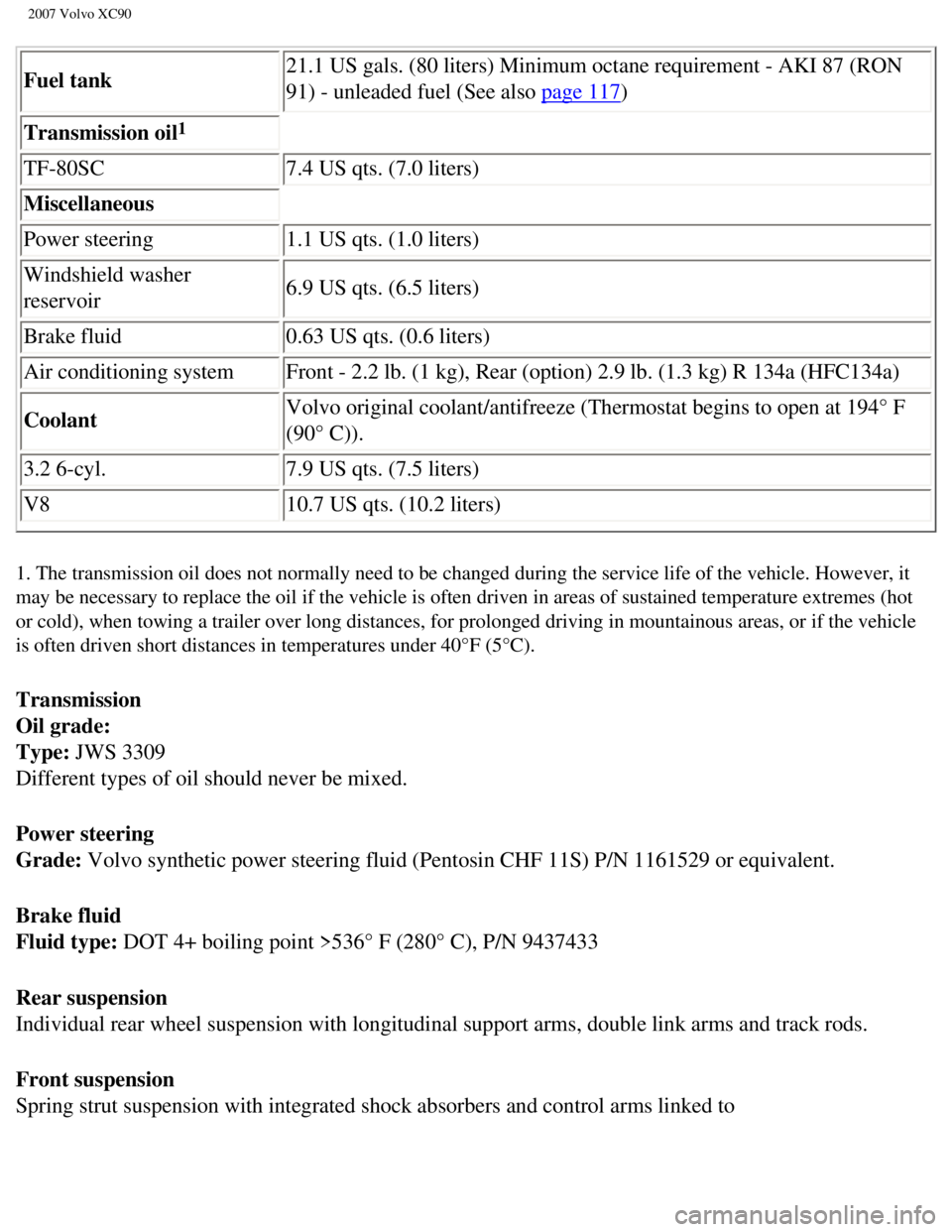
2007 Volvo XC90
Fuel tank 21.1 US gals. (80 liters) Minimum octane requirement - AKI 87 (RON
91) - unleaded fuel (See also page 117)
Transmission oil
1
TF-80SC 7.4 US qts. (7.0 liters)
Miscellaneous
Power steering 1.1 US qts. (1.0 liters)
Windshield washer
reservoir 6.9 US qts. (6.5 liters)
Brake fluid 0.63 US qts. (0.6 liters)
Air conditioning system Front - 2.2 lb. (1 kg), Rear (option) 2.9 lb. (1.3 kg) R 134a (HF\
C134a)
Coolant Volvo original coolant/antifreeze (Thermostat begins to open at 194°\
F
(90° C)).
3.2 6-cyl. 7.9 US qts. (7.5 liters)
V8 10.7 US qts. (10.2 liters)
1. The transmission oil does not normally need to be changed during the \
service life of the vehicle. However, it
may be necessary to replace the oil if the vehicle is often driven in ar\
eas of sustained temperature extremes (hot
or cold), when towing a trailer over long distances, for prolonged driv\
ing in mountainous areas, or if the vehicle
is often driven short distances in temperatures under 40°F (5°C)\
.
Transmission
Oil grade:
Type: JWS 3309
Different types of oil should never be mixed.
Power steering
Grade: Volvo synthetic power steering fluid (Pentosin CHF 11S) P/N 1161529 o\
r equivalent.
Brake fluid
Fluid type: DOT 4+ boiling point >536° F (280° C), P/N 9437433
Rear suspension
Individual rear wheel suspension with longitudinal support arms, double \
link arms and track rods.
Front suspension
Spring strut suspension with integrated shock absorbers and control arms\
linked to
file:///K|/ownersdocs/2007/2007_XC90/07xc90_10.htm (7 of 10)12/30/2006\
5:53:52 PM
Page 262 of 268
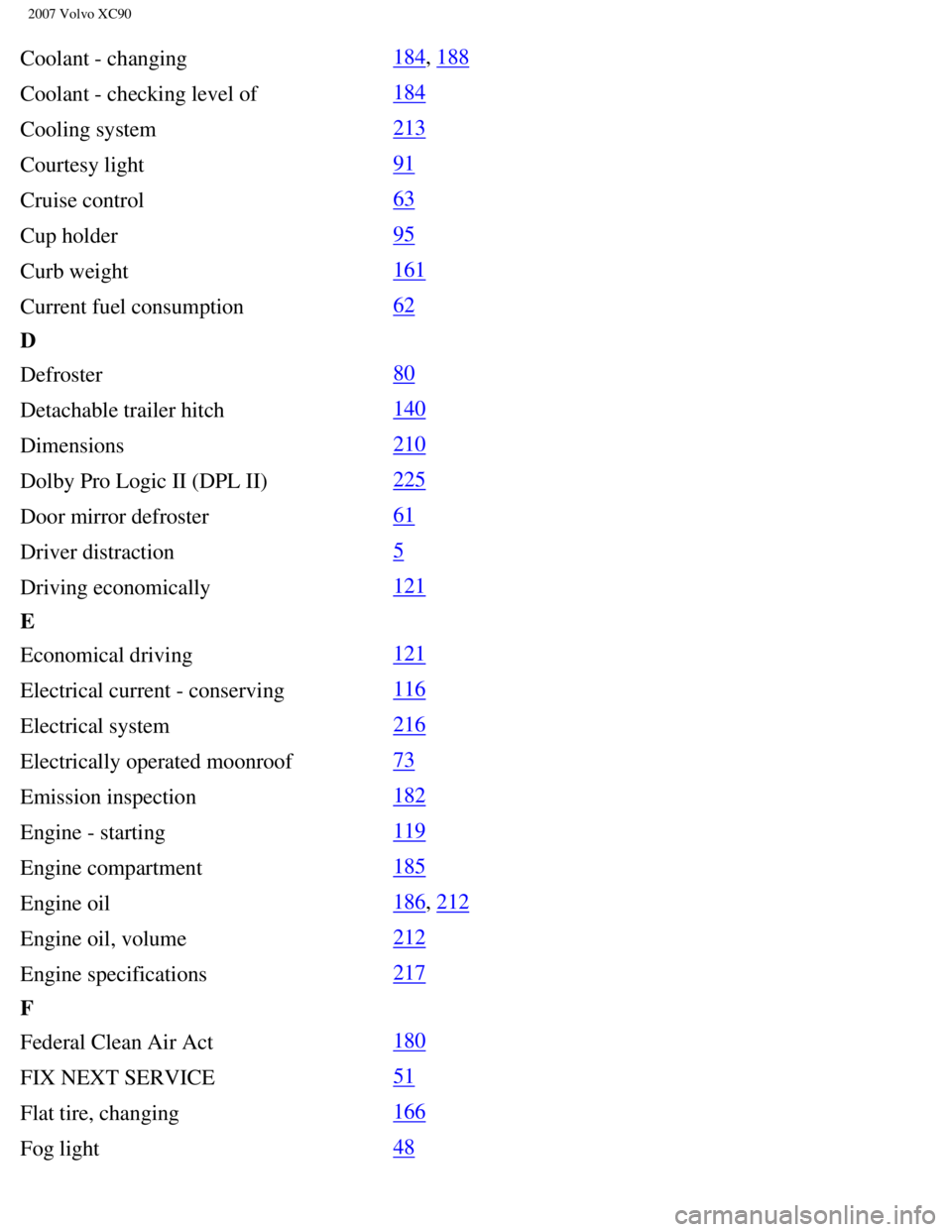
2007 Volvo XC90
Coolant - changing 184, 188
Coolant - checking level of
184
Cooling system
213
Courtesy light
91
Cruise control
63
Cup holder
95
Curb weight
161
Current fuel consumption
62
D
Defroster
80
Detachable trailer hitch
140
Dimensions
210
Dolby Pro Logic II (DPL II)
225
Door mirror defroster
61
Driver distraction
5
Driving economically
121
E
Economical driving
121
Electrical current - conserving
116
Electrical system
216
Electrically operated moonroof
73
Emission inspection
182
Engine - starting
119
Engine compartment
185
Engine oil
186, 212
Engine oil, volume
212
Engine specifications
217
F
Federal Clean Air Act
180
FIX NEXT SERVICE
51
Flat tire, changing
166
Fog light
48
file:///K|/ownersdocs/2007/2007_XC90/07xc90_12.htm (3 of 9)12/30/2006 \
5:53:56 PM